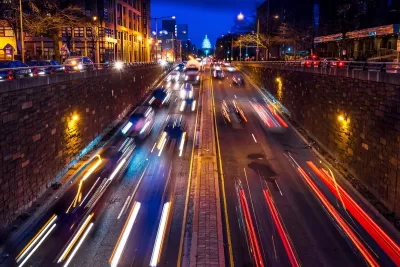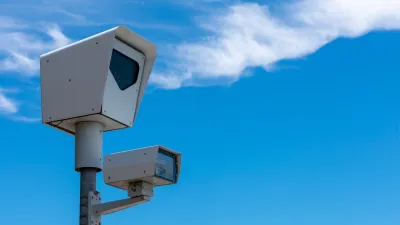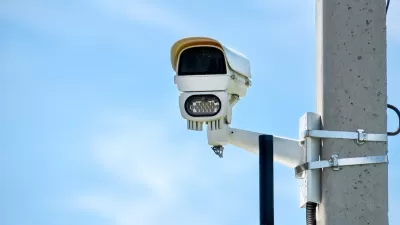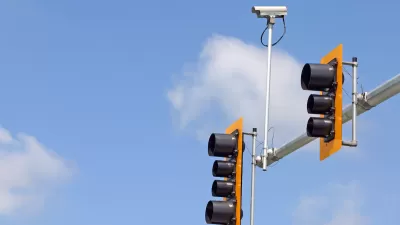Automated enforcement is reducing speeding, but bigger changes to street design and the built environment are needed to make the District’s streets safer and more pleasant for people walking.

In a deep dive in Greater Greater Washington, Pete Rodrigue describes how the Washington, D.C. District Department of Transportation is using automated traffic enforcement to improve road safety and reduce interactions with police. The District recently doubled the number of cameras on the streets in the last year, leading to a large increase in tickets issued between 2022 and 2024, with the District issuing over 250,000 tickets in May 2024.
Rodrigue includes data about how many tickets actually get paid, noting that ticket revenue fell sharply during the Covid-19 pandemic and has not returned to pre-pandemic levels. “This appears to be due to the fact that each camera has been resulting in less revenue because of drivers’ nonpayment,” Rodrigue adds.
As to the question of whether cameras are effective, data shows that cameras tend to issue fewer tickets over time, signaling that drivers who get used to seeing them are less likely to speed. Notably, “studies find that cameras reduce total crashes by roughly 20%, at least in the area around the camera. Traffic cameras may also lower pedestrian injuries, although fewer studies estimate this directly, and some research has found mixed results.”
Rodrigue also highlights the ways that cameras can’t fix our broken built environment: while they might discourage drivers from speeding, they don’t make roads with poor pedestrian infrastructure safer or more pleasant to walk on. And while cars might be moving more slowly, they can still injure or kill pedestrians, even when driving the speed limit. “There’s actually some evidence that the people who speed a little bit on badly designed roads may cause more pedestrian deaths than the small number of people who drive significantly over the limit.”
Ultimately, automated enforcement can still perpetuate inequities baked into our transportation planning. They are just one tool of many needed to improve U.S. road design to limit pedestrian injuries and deaths and make roads safer for everyone who uses them. As Rodrigue points out, “cameras alone will not refashion badly designed stroads into more humane, livable streets. They will not prevent the many crashes that occur within posted speed limits. And without a thoughtful approach, which the District has yet to develop, automated traffic enforcement risks punishing Black and low-income drivers for the sins of traffic engineers.”
FULL STORY: Smile, you’re on camera: A deep dive on automated traffic enforcement data

Planetizen Federal Action Tracker
A weekly monitor of how Trump’s orders and actions are impacting planners and planning in America.

Congressman Proposes Bill to Rename DC Metro “Trump Train”
The Make Autorail Great Again Act would withhold federal funding to the system until the Washington Metropolitan Area Transit Authority (WMATA), rebrands as the Washington Metropolitan Authority for Greater Access (WMAGA).

The Simple Legislative Tool Transforming Vacant Downtowns
In California, Michigan and Georgia, an easy win is bringing dollars — and delight — back to city centers.

The States Losing Rural Delivery Rooms at an Alarming Pace
In some states, as few as 9% of rural hospitals still deliver babies. As a result, rising pre-term births, no adequate pre-term care and harrowing close calls are a growing reality.

The Small South Asian Republic Going all in on EVs
Thanks to one simple policy change less than five years ago, 65% of new cars in this Himalayan country are now electric.

DC Backpedals on Bike Lane Protection, Swaps Barriers for Paint
Citing aesthetic concerns, the city is removing the concrete barriers and flexposts that once separated Arizona Avenue cyclists from motor vehicles.
Urban Design for Planners 1: Software Tools
This six-course series explores essential urban design concepts using open source software and equips planners with the tools they need to participate fully in the urban design process.
Planning for Universal Design
Learn the tools for implementing Universal Design in planning regulations.
Smith Gee Studio
City of Charlotte
City of Camden Redevelopment Agency
City of Astoria
Transportation Research & Education Center (TREC) at Portland State University
US High Speed Rail Association
City of Camden Redevelopment Agency
Municipality of Princeton (NJ)





























